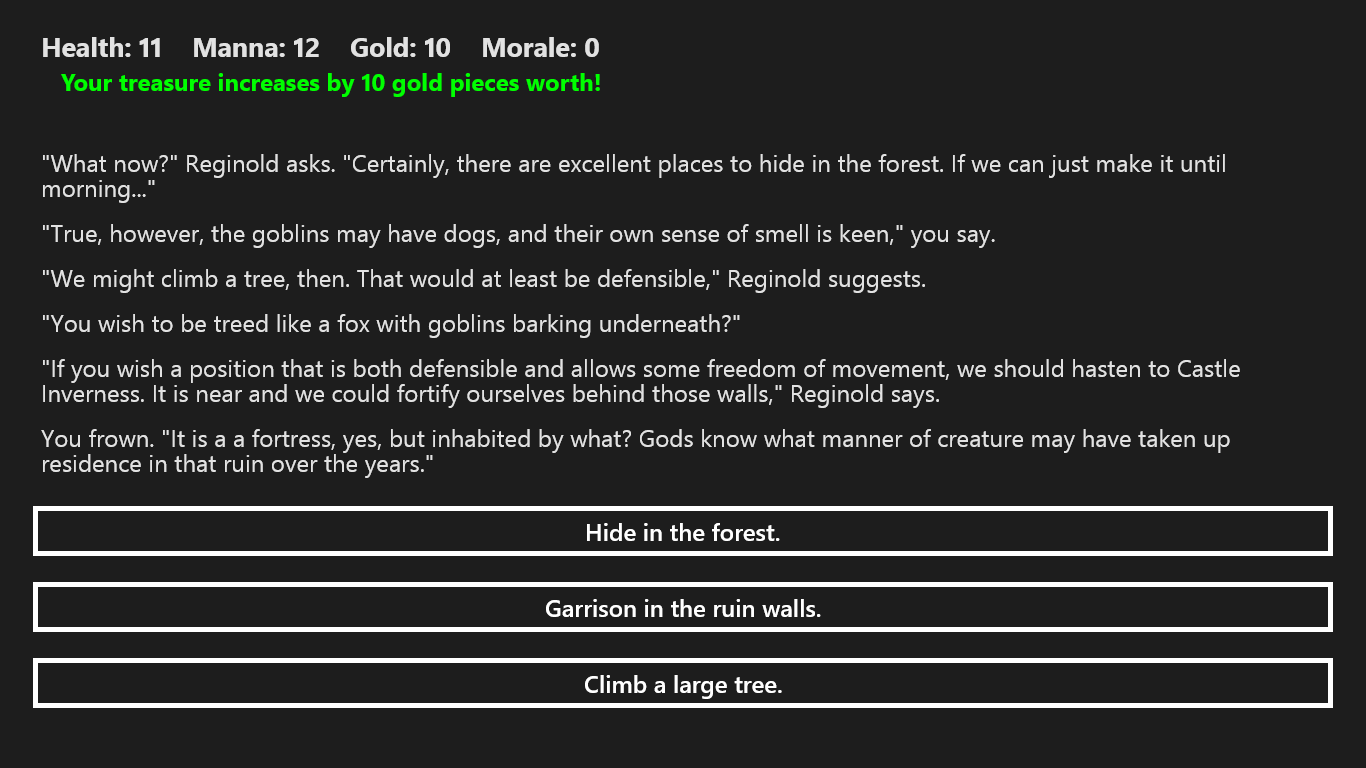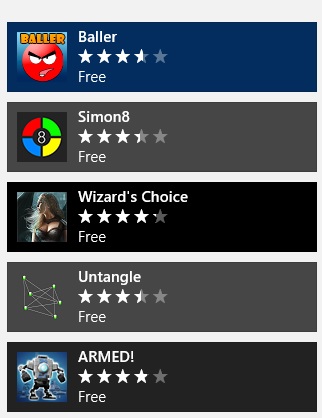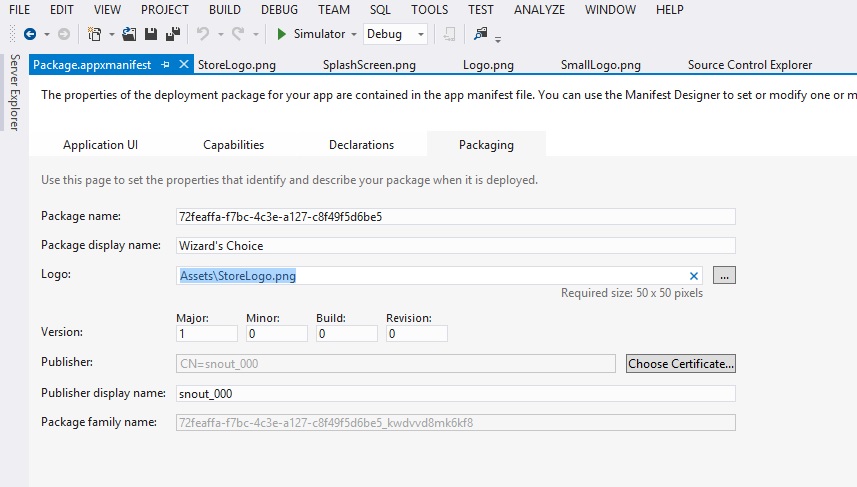5 ways to help your game or app gain mass appeal (Windows Phone & Windows Store)
An application or game does not have to be flashy or sophisticated to please customers and get lots of downloads. My simple text adventure games (Wizard’s Choice and Zombie High Volume 1) have had 800,000+ downloads of Windows Phone and Windows Store versions over the last year and has been in the top 100 free games on both stores. Yes, I’m talking text adventures. I’m talking 1980’s! As a matter ‘o fact, my games are simple even by text adventure standards because there’s no free-form input from the reader (e.g. “use key”, “pull lever”, etc. like in ZORK), rather, you just push buttons to make decisions (think Choose Your Own Adventure with stats). So how did this happen? Well, I love to write fiction and so I like to think that the content’s pretty good; however, there were 5 elements in my game that I think helped a lot:
- Keep it simple
- Works great, no bugs
- Great Store art and icons
- Encourages your users to help you
- Give something of value away for FREE
Notice what's *not* on the list:
- Sweet graphics and animations
- Advertising outlays or other promotions
Of course these two items are helpful; however, in my experience, the previous 5 elements have disproportionately high return on investment, so I recommend you nail them. Below, I go through the five elements in detail:
Keep it simple
More features means more complexity of UI which means your customers are going to have a higher learning curve. If they don’t get some reward within seconds of opening your app or game, then you’ve already lost a large percentage of your customers. Perhaps worse, more features means more testing surface area and more bugs. The bottom line is that you should ship with the bare minimum required to get the job done well.
Wizard’s Choice is an extreme example of “keep it simple”. From the time you open the game, all you do is press “next” or make choices presented to you.
Below is a screenshot of my game at its most complex—there are buttons at the bottom. Pick one.
Wizard’s Choice is so stripped down that it doesn’t even have a “Save Game” or “Load Game”, rather, your one game is automatically saved after every choice and that game is loaded when you restart the app. Heck, it doesn’t even have an inventory system. What kind of self-respecting fantasy RPG can ship without an inventory system? “How can I tell what magical potions I have?” “How can I swap out my ordinary boots with magical boots of flying?” Now I’m not saying that you shouldn’t have these basic features, what I’m saying is that I thought I could get away without them and so I shipped it and watched for feedback from my customers. No one complained and I was getting excellent ratings, so I have no incentive to add more complexity.
Just recently, after repeated requests from my customers on my ratings feedback, I’ve finally decided to include checkpoints for saving your game. People were tired of dying and having to start back from the beginning. I don’t blame them, but since my ratings were high and adding this would add more testing, I didn’t do it. After all, even with this simple added feature I have to deal with the following:
- Where to put these checkpoints?
- Will they mess up game balance and make it too easy?
- What if the user goes back to a state where they can’t win? That means I’ll have to give them an option to start over, which means another screen.
Granted, adding checkpoints is no feat of engineering, but it still adds cost to develop, risk of bugs, and more code to maintain. The bottom line is add features reluctantly and only after clear customer feedback.
My game is not typical of most apps and games you’ll see out there. I was able to get away with an incredibly simple design because the real value of my game is in the written content, not the engineering. I love to write fiction on the bus and on the weekends so shoveling countless hours into this was a pleasure. Your app or game will likely require more complexity to be of value, but complexity does not necessarily equal value, indeed, “less is more” has been a design staple for a long time so think hard about what you get away with not doing.
Works great, no bugs
If you’ve done your due diligence keeping it simple, this part is going to be easier. First, your app has to do what it was advertised to do well. About the only way to tell this before shipping is to give it to other people (people you trust to be brutally honest) and let them bang on it. Look over their shoulder if you can. Make them speak out loud about what they’re doing and why. After all, you’re not a mind reader. If they’re not telling you enough, ask them questions. “Why did you do that?”
As important as pretesting is, the real test is after you ship it live. I ship my games on several platforms and so I usually ship it first on a platform I care less about and obsessively watch the customer rating comments. Once it has been through this test and I’ve made the adjustments I need, I update the game on my “scout platform” and then ship it on the others.
Likely, there will still be bugs even after this. I have a Facebook page (advertised at the end of levels in my game) that customers sometimes use to message me bugs. I’ve probably fixed more bugs via Facebook feedback than through rating comments because people don’t typically like to write in-depth bug repros in ratings, especially if they don’t know if you’re even reading them. I recommend you give your customers a way to contact you other than through ratings. Not only will this help you get better feedback, it’s just a good PR move.
The bottom line is customers hate bugs and in my experience bugs do more damage to ratings than anything and your ratings are the lifeblood of your app’s success. When people rate your app, they’re looking for reasons to not give you five stars. Your app could cure cancer, but if it has a bug people will dock stars. Again, the pretesting and “scout platform testing” above does a lot for me to work out bugs. And of course my game is dead simple to begin with, so bugs don’t damage my ratings anymore.
Great Store art and icons
People judge a book by its cover and so it goes with apps. Your icon, the tiny 50x50 pixel image is the single most important piece of art in your app and it alone can be the difference between success and failure. When your customers see your little icon in a lineup with other apps, yours needs to stand out.
For Windows Store apps, remember to set your store icon in the app manifest. When you open the manifest file in Visual Studio, the Application UI tab is highlighted by default and you set a logo for your app there; however, you need to click on the “Packaging” tab in order to ensure your store logo is set. In terms of getting downloads, you Store Logo is probably more important than the logo associated with your app that people see after they have downloaded it. Personally, I use the same art for both.
Of course don’t skimp on your screenshots. If you’ve managed to get someone onto your store page, you don’t want to lose them now simply because your screenshots aren’t compelling. This might seem obvious, but it’s easy to hurry through this step because you’re eager to ship—take a breath and spend some time to get this right. There are instructions in the Store wizard that describe what makes good screenshots.
Finally, there’s the Start Icon that shows up on the Start menu. You want this to be compelling so that when they look at their Start menu, their eyes are drawn to your art and they want to click on it.
Where were your eyes drawn to in the image above? Did you want to click on the young woman with the dagger?
I recommend leaving good art to the artists. If you know a great artist, good for you, otherwise, I suggest using a site like elance.com or guru.com to post your project for bid. I’ve found some great artists this way. These sites take care of the taxes and all the other painful stuff associated with outsourcing. This might cost you a couple hundred bucks, but what’s that compared to the thousands worth of labor you put into making this thing? Don’t skimp on art or you will severely hurt your downloads
Encourages your users to help you
Basically this boils down to encouraging your users to spread the word and give you good ratings. Personally, I do a little groveling at the end of each volume of my text adventure that goes like this:
“Shameless plug: Please rate this app, preferably a good one!"
Hey, it doesn’t hurt to ask and it sure is a cheap way to boost your ratings—again, the lifeblood of your success. I don’t have hard data on whether this is having a significant effect, but appealing to people’s better nature (or sense of guilt for getting something valuable for free) seems like a no-brainer. It’s simple and adds no testing surface.
Something I saw in another game was to offer game currency to anyone who rated it. I played the game and tried to figure out how the game was able to detect whether the user rated it and as far as I could tell, the game could not do this, rather, it was using the honor system. Nevertheless, it seemed to work since many of the ratings said “Doing this for the points.”
As far as spreading the word to others to download your app, I haven’t personally looked into this much. I was thinking of tying into Facebook or some other such scheme to lower the friction for users to spread the word, but I haven’t gotten around to it yet. As I mentioned above, I do point people to my Facebook page at the end of every chapter of my game. These customers are very valuable to me because they jump on any new release I put out, which is great for an initial boost and it gives me timely feedback because they are early adopters. Note that if you do this, don’t expect a ton of “likes” since I get well under 1% for every download of my game. Another benefit I get from direct contact is 5-star ratings. If someone posts "Great job on your app" on my Facebook page, I respond with "Thanks for the props! BTW, have you rated it yet? I appreciate it!" or something to that effect. Hey, every rating counts.
Give something of value for free
In terms of getting downloads, there is NOTHING like the power of FREE. If you want large downloads, using the power of FREE is mandatory. Of course it’s nice to make money and so you have a few options for giving something away of value while still making money:
- Ad supported. The advantage of this is that you’re giving everything away for free, not just a few levels, or some hobbled version of your app that they have to upgrade, etc. This makes for the best ratings. The disadvantage is that ad revenue can be low depending on a lot of factors.
- In-app-purchase: This is good if you’re app can be sectioned off so that you can give away a fully functional app that is of value for free, but would be even better if you upgrade.
- Loss leader: This works best if your app is part of a series. So, since I’m using interactive books, I give away the first volume for free and sell the sequels for $.99 or $1.99.
And of course you can combine models, with ads being the most likely addition. For example, you can add ads to the free first volume of a series or have ads in your app and offer an ad-free upgrade using in-app-purchase. You have a lot of combos to choose from, be careful. You don’t want to annoy your users and lower your ratings. I blog about making money here: Making money with my Windows Store game
Conclusion
You can read entire books on how to get the engineering right (e.g. share code between platforms, MVVM, optimizing performance, etc.) and obviously that’s all important, but in the end, it can be the non-nerdy stuff that makes the difference between success and failure. So don’t pour your soul into an awesome product just to fall down on the easy stuff. That’s just tragic.
What about you?
Do you have any killer tips for getting downloads? Please comment. If you include something that ought to be in this post, I'll include your tip with a quick acknowledgement.
Writer profile and disclaimer
Sam Landstrom is an individual writer for MSDN and the comments in this post do not necessarily reflect the opinions of Microsoft as a whole.



